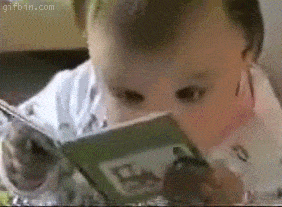How to read differently to better interpret ?
A good voiceover artist knows how to read a script aloud in a few seconds without stammering, with the right intention, the right tone and without having studied it first.
In addition to good vocal techniques, the voice-over artist must know how to read effectively.
No more jerks, after reading this article, you will learn what are the 6 steps to mastering the reading method.
1. Mastering speed reading
What are the rules ?

The principle is to read 2,3,4 times faster, compared to the speed of an average reader to save time, it performs what is called a skimming, which is to read by locating the keywords. A speed of reading more than surprising.
For your personal culture, I invite you to watch a small report on Magali Rozo, French speed reading champion capable of reading a 400-page book in less than 2 hours and explains how to practice the technique of note taking in the form of mind mapping.
What is a fast speed ?
That's the reading rate of 1,000 words per minute, does that tell you anything?
When you think that the average voice-over reading time per minute is supposed to be 150/160, it makes you think.
There are 4 speed levels:
Slow speed: 100 to 150 words per minute
Average : 200 to 250 words
Intermediate : 400 words
Fast : Only 1 minute to read 1000 words
A quick aside on what we, as human beings (except me 🙂 ), may be able to do with practice.
A little too quick a read for my taste😲. Don't worry, you will never be asked to do the same thing as a voiceover.
Some reading tests to have a little fun and to locate your level:
Why did I use this example ?
Because other factors must be taken into account, in order to read quickly and efficiently, you must also learn to articulate and breathe.
To be fair, the voiceover actor should be able to read faster, but... Without actually doing it, let me explain :
3 main speed reading techniques
There are several categories of active reading techniques :

1. Visual guide technique
Consists of reading slowly using your finger, a pen, a pencil
bookmark, ruler...or any object that can be used as a pointer to follow each word of the text (remember elementary school).
Just the opposite of reading diagonally

2. The sweeping technique
It is being able to read lines continuously without any pause, a faster reading than the 1st example.

3. The global technique
It is about having peripheral vision and memorizing. It's like skimming over words. The reader must be able to start a sentence having already anticipated the next 6 words.
It is this step 3 that will interest us as a professional voiceover artist.
An "amateur" voice-over artist tends to stumble over words, stammering and repeating themselves multiple times before finishing the reading.
That's what we've been taught since we were kids (at least, for some of us), to read word by word and not in its entirety
It is now a matter of getting the eye used to doing the opposite of what we were taught to read more easily, i.e. anticipating the next 5 or 6 words so as not to lose the understanding of the text and visualizing the punctuation, without accelerating the speed of phrasing. Do you follow me ?
Remember the essentials : To practice reading aloud, the voice actor must adopt an efficient reading style and read very quickly to work on his articulation AND breathing.
Over time, they will get used to seeing the following words "ahead of time", for a fluid and comprehensible reading.
So, you know what I'm saying ?
2. Learn expressive reading to better interpret

It sets the tone for what the voiceover will explain or tell.
To interpret a script, the narrator must become immersed in the character, whoever that character may be.
A briefing always takes place between the client and the voice actor to set the tone.
But if it is not the case for x reason, we know for example that an institutional is rather informative and straight, a motion design is most of the time dynamic, all that can help to position on the starting tone.
Two basic questions to ask yourself before reading his script :
Who is speaking ?
Who do we speak to ?
The idea is to highlight the narrator while knowing who the listener is, as if you were scouting.
A character for a storybook is addressed to a child
A reporter for a news story addresses the adult population
A business owner who wants to sell his services talks to a potential client
The tone must be adapted according to the emotion you wish to convey, whether it be joy, anger or sadness.
The voice-over talent knows how to use his or her voice tool, and will play with the volume and speed of his or her reading to make the script come alive and keep the listener alert.
3. Using non-verbal communication

That's all the information you can convey, not with words, but with your body.
You think that in voice-over there is no point in using non-verbal communication because we are not seen.
Wrong.
A good voice talent will never stand stiffly in front of a microphone, but will need to use the whole "upper" part of his body at the same time as he uses the words to interpret.
This is what will help him to become part of his character. The feet remain firmly anchored to the ground, no parasitic noise should interfere with the sound of the microphone.
4. Respect the punctuation

A well-written script is punctuated when it should be, where it should be (I'd better make sure) and should be read well.
Let's take an example :
"I didn't, well, hear it"
If this sentence is read without putting a pause after the comma, it is understood that the person did not hear something well, when in fact he is not in possession of an object.
If the voice-over does not follow this punctuation, it loses what is called the intelligence of the text, so it does not understand the meaning of what is said and neither does the listener.
What is the purpose of punctuation ?
To give direction to the text. The intonation will be
- Ascending, with the question mark and exclamation mark
- Downward, with the point
To make pauses between two sentences
- After the exclamation point
- After the point and two points
- After the comma
To put movement in the voice (inflections)
Think you already know everything ?
5.Work on your articulation

Isn't it essential when speaking to someone to articulate well ?
To not have to go backwards every time you get stuck on a word?
To do this, the mouth, the jaw, the palate and the tongue are simultaneously put to work to pronounce each word correctly. All syllables must be well articulated to improve reading.
That's why it's important to do exercises every day to warm up. Reading without articulation is anything but fluid.
Not only will you improve your diction, but also your breathing. Practice staying on one breath as long as possible.
Some examples of "tongue twisters" to practice every day and become an expert in articulation. The goal of the game is to read as fast as possible without stammering, GO!
"Cherchez ce chat chez ce cher Serge".
"J’ai bu un bien bon verre de bien bon vin blanc vieux".
"Babylas baladin emballe bonnement des balles tandis que Babette ballerine étoile du corps de ballet se balance mollement sur le bout d’une barre de bois."
And the eyes in all that ?
6. Muscle your eyes

You've learned to read like a pro, but if your eyes are tired, you may not be in the best condition to work.
You need to take care of your eye system as much as your voice. After all, it too is under constant strain.
Here's what you should do every day to muscle your eyes and prevent them from getting tired.
Sitting (or standing) with your back straight, look straight ahead, your head should not move during the exercises.
Move your eyes from left to right (without moving your head), start with 1 series of 10
Then from bottom to top, 1 series of 10 on each side
On the diagonal
Finally, do circle movements, always 1 set of 10 on each side.
You may feel a little dizzy, but over time you will get used to it and improve your vision.
You now have all the tools to prepare yourself to become a voice over pro, at least as far as reading is concerned, the rest is to come.
Female voice, male voice, as usual, I encourage you to work hard and believe in yourself, these are the two main keys to break into voice over.
